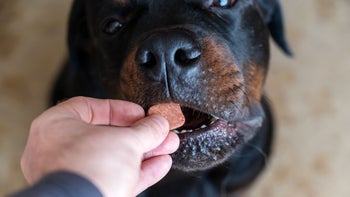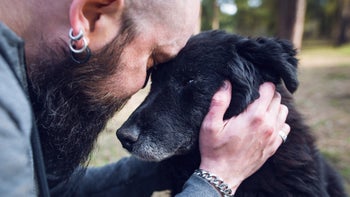
Dog Constipation: How to Treat It at Home and When to Get Help
Key takeaways:
Constipation in dogs can sometimes be managed at home by improving your dog’s diet and exercise routine.
Boosting the moisture content of your dog’s diet and feeding them high-fiber foods can relieve constipation and prevent it from recurring.
When constipation persists, it’s important to consult a veterinarian, who can determine the cause and the best path forward.
Table of contents

We all get constipated from time to time, so it’s no surprise that our dogs also struggle to poop sometimes. But if your dog has frequent bouts of constipation, you may need to make some changes to their routine, including their diet and exercise.
Constipation can sometimes be treated at home. Here are some strategies to try, as well as tips to help you determine whether you should enlist help from a veterinarian.
At-home constipation remedies
Constipation is frequently caused by dehydration, dietary deficiencies, or a sedentary lifestyle. The following strategies may help prevent constipation.
Search and compare options
1. Increase water intake
Be sure that your dog has access to fresh water at all times. If you feed them kibble, try boosting the moisture content of their meal by mixing in canned food or switching to canned altogether.
2. Increase fiber intake
Several high-fiber fruits and vegetables are safe for dogs and can quickly relieve constipation (see suggestions below). You can also try giving your dog moderate amounts of bran cereal or a product such as Metamucil, Konsyl, or Siblin.
3. Take them out to exercise
Taking your dog for a walk or out for a quick game of fetch will improve their blood circulation and stimulate movement in their gastrointestinal tract.
4. Go for more frequent bathroom breaks
If your dog struggles with constipation, it may help to give them more bathroom breaks. Giving your dog more opportunities to poop may help keep things moving.
At-home constipation remedies to avoid
Contrary to popular advice on the internet, do not give your dog coconut oil or olive oil. These can be harmful to your dog. Apple cider vinegar and mineral oil are not typically recommended by veterinary experts.
It’s also best to avoid giving your dog yogurt. Yogurt contains probiotics, but it also contains lactose, which some dogs are sensitive to. In addition, yogurt (and other human foods) may be sweetened using xylitol, which is very toxic to dogs.
Anal gland expression: Most dogs’ anal glands are naturally expressed when they poop. But here’s what to know if your dog needs manual expression.
Dog diarrhea: If your dog has runny poop instead of constipation, learn how you can help your pup.
Not eating: When dogs aren’t eating with their usual gusto, it can be a sign of a medical condition. These are the most common reasons dogs stop eating.
Best high-fiber foods for dogs
Adding these safe high-fiber foods to your dog’s diet or offering them as treats may relieve their constipation:
Canned pumpkin
Bananas
Blueberries
Cantaloupe
Strawberries
Broccoli
Carrots
Green beans
Plain oatmeal
When to try laxatives for your dog
When all else fails, it may be time to try a laxative. Dogs with mild constipation can take human laxatives such as polyethylene glycol 3350 (Miralax) or bisacodyl (Dulcolax). But it’s important to consult a vet for guidance and the correct dosage.
Using laxatives on a regular basis can also make your dog’s constipation worse.
When to see a vet about your dog’s constipation
Most dogs poop at least once per day. It’s a good idea to call a veterinarian if your dog is going less often and you observe any of the following symptoms:
Scooting
Decreased appetite
Squatting frequently but only pushing out small amounts of watery stool
Weight loss
Crying or growling when touched on the abdomen or back
Your veterinarian can rule out serious medical conditions such as an intestinal obstruction, pelvic injury, or an enlarged colon (known as megacolon). They can also prescribe laxatives or give your dog an enema if needed.
Frequently asked questions
The best foods to help dogs poop are high in fiber. Good options for a constipated pup include:
Canned pumpkin
Bananas
Blueberries
Strawberries
Broccoli
Carrots
Green beans
Plain oatmeal
The human laxatives polyethylene glycol 3350 (Miralax) and bisacodyl (Dulcolax) can be safe for dogs with mild constipation. Before giving your dogs these human laxatives, ask your vet for advice on the best dosage for your dog.
The best liquid for dogs with constipation is good old water. In addition to keeping out plenty of fresh drinking water, try feeding your dog a canned diet. You can also mix their regular dog food with additional water to increase their hydration.
The bottom line
If your dog is constipated, there are some remedies you can try at home. Improving your pup’s hydration, adding fiber and natural stool softeners to their diet, and getting them moving more often are all good strategies. If those strategies don’t work, ask a vet, who can help determine the cause of your dog’s constipation and the best treatment path.
Why trust our experts?



References
American Society for the Prevention of Cruelty to Animals. (2021). Sharing is caring: Foods you can safely share with your pet.
Brooks, W. (2023). Constipation and megacolon in dogs and cats. Veterinary Partner.
Defarges, A. (2020). Constipation and obstipation in small animals. Merck Veterinary Manual.
Teft, K. (n.d.). Management strategies for constipated dogs and cats. DVM360.
U.S. Food and Drug Administration. (2021). Paws off xylitol; it's dangerous for dogs.
Wismer, T. (2018). People foods to avoid feeding your pets. Veterinary Partner.

























